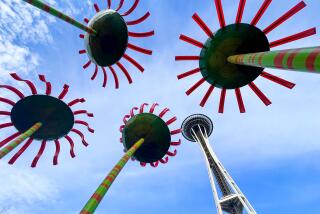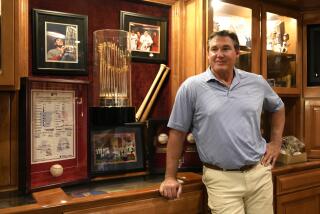TRAVELING IN STYLE : KINGS OF SPORT : AN ALASKAN ADVENTURE: BATTLING THE GIANT CHINOOK
- Share via
I walked out of the Ketchikan brothel and bumped into James Michener, the esteemed 79-year-old writer--who was going in. “Astonishing meeting you here,” he exclaimed. “What are you doing in Alaska?” “Catching a plane for what I hear is the best fishing in the state,” I said. Michener looked only a little more grizzled than he had when I’d seen him eight years before in Santa Barbara. “My wife and I are the only ones on that big yacht out there on the bay,” he said. “Come on out for a drink after I check this place out.” It should be mentioned that the brothel in question, Polly’s Place, has been defunct for, lo, these many years and is now a tourist stop on Ketchikan’s colorful Spring Street. Later we had that drink aboard the fanciest yacht I’ve ever seen--cost $13 million, plus $10,000 per day to operate, a crew of 14--and for a short while I knew what it was to feel like the rich and the famous. “I wish I were going where you’re going,” Michener said wistfully. “I’ve heard about Waterfall Resort.” After a pleasant hour, my wife and I left the Micheners and took off in a 20-passenger floatplane headed for a unique adventure in fishing. As the product of Montana parents and grandparents, my first glorious childhood memories are of pulling trout out of Big Timber Creek in that state. I return there every chance I get to fish trout waters--from the Bitterroot in the western part to the Bighorn in the east and the Madison in between. I’ve also fished the East Walker in California, the Galashiel in Scotland and the Wairaki in New Zealand. But until last August I’d never fished in our 50th state. Nor had I ever caught a salmon in fresh or salt water. I was looking forward to it; maybe too much. Was it all true what I’d heard about Alaska fishing? That the fish practically jump into the boat?
For half an hour our Twin Otter hummed over sunlit islands and bays shaped like the dark-green pieces of a very intricate jigsaw puzzle. We were now over the pristine wilderness of Prince of Wales Island. One hundred and thirty miles long and 45 wide, it is the third largest in the United States, only Kodiak Island and the Big Island of Hawaii being larger.
Suddenly, long shed-like buildings appeared below us, the plane banked into a steep circle and dropped its nose, and in a few minutes we were skimming over the smooth water to the dock. Already we could see fish jumping--lots of them and of a good size. I began to get excited.
Pete Gherini, one of the owners of Waterfall, fortyish and with a big boyish grin, welcomed us and showed us around the resort. Founded in 1912, Waterfall was considered one of the largest and finest canneries in the world. (In 1936, it put up about 220,000 cans of salmon, a record for a single cannery at that time.) In 1970 the layout was converted into a resort dedicated to the proposition that you don’t necessarily have to be ill-fed and miserable in order to catch fish. Lots of fish.
Gherini showed us the elegant little cottages, dining room and store for sundries--also the building where the daily catch of the guests is processed, flash-frozen, packaged and ultimately shipped for them. There are no more than 72 guests at a time, with 68 employees on the alert to see that they are well taken care of.
Along the way, Gherini detoured past the pond so that we could view the big black bears, five of them this day, feeding as usual in the ravine beyond the line of cabins. Although the bears were engrossed in the kitchen leftovers, Gherini cautioned us to stay a healthy couple of hundred feet away. Although they are accustomed to people, they are anything but tame; they run hardly less fast than a racehorse, and they each weigh about 500 pounds.
In back of the buildings is the lovely waterfall that gives the resort its name--wide and lacy cascades of water rather than the usual high, narrow and roaring ones. I asked if there were trout there.
“Small ones,” Gherini said, “only about 15 inches.”
We stowed our luggage in a sunlit cabin at the edge of the bay, and I went down to the long dock where several boats were. My guide was waiting on his 21-foot cruiser. There is an experienced guide for every four people, and my fishing companion turned out to be comedian Jonathan Winters, an ardent fisherman. A great water bed of a man, the ex-Marine was outgoing, friendly and constantly entertaining; he had our guide, Bob Person, in such hysterics before we’d even cast off that I never thought we’d get serious about the business at hand.
We put out into the bay and headed south, our 175-horsepower outboard really pushing us along. With the calm water and surrounded by a sheltering island, it was hard to believe that we weren’t on a placid lake instead of the Pacific Ocean.
“After that island over there,” said our bearded guide, pointing, “the next stop is Japan.”
As though to remind us that this was, indeed, the ocean, a 30-foot humpback whale leisurely surfaced a scant 20 yards from our boat. Closer to shore, bald eagles dived for fish.
“Sometimes they drown doing that,” Person said. “Get those talons hooked in a fish too big for them to lift and can’t get loose.”
We saw a great black bear with cubs fishing an inlet, and not far from the bears Bob switched to the trolling motor and put out the lines. We were using gear furnished by the resort--light boat rods, 20-pound test line, and herring for bait. The motor kept up a steady chung-chung-chung as we trolled slowly along the beautiful coast.
Jonathan had the first strike and was elated when, after a tough fight during which the fish broke water three times, he eased about an eight-pound salmon next to the boat. It looked like a fine beginning to me, but Bob shook his head and released the fish. “We don’t generally keep the pinkies--humpies, we call ‘em. We’re after cohos--silvers. And kings, or chinooks, though it’s pretty late in the season for them.”
We fished for another hour with nary a strike. This was the famed Alaska fishing?
“Tide’ll change pretty soon,” Bob said. “Then look out.”
Jonathan made the time pass quickly with wonderful Granny Frickert stories, and one in which he reproduced a dialogue between two fish criticizing the technique and lures of the fisherman in the boat above them. “Poor devil barely knows how to cast that ugly thing,” says one fish. “Think I’ll just grab it this time and make his day. Watch! OK feller, I’ve got it now, but don’t horse me, don’t horse me! You’ll lose me for sure.”
I was relaxed and laughing when the rod suddenly came alive in my hands with a sharp yank. Then nothing.
“Don’t strike him,” Bob ordered quietly. “Feed him line, feed him line!”
I stripped out some line, waited tensely, and in a few seconds came an answering grab--and this time for good.
The reel screamed like an ambulance as the fish headed in the general direction of Japan. I let him go--let him, hell, he gave me no option! I tried to slow him up when we got down to the backing, and then into the air he exploded.
“About 30 to 40 pounds?” I gasped, reeling frantically in between jumps, the rod bowed almost in a circle.
Bob chuckled. “Maybe 15, if you’re lucky.”
I told you I didn’t know anything about salmon.
The coho broke water spectacularly four more times, twisting and slashing in the golden afternoon sun, then slowed his runs down abruptly.
“Reel him in now,” Bob said.
“I want to play with him some more.”
“Get him in” Bob said, “and you can play with him in the bottom of the boat all you want.”
Before I could get my fish into the boat, Jonathan had hooked one and it was even bigger.
In the next hour and a half we each caught our limit of six salmon, the smallest of which was 13 pounds, the largest, a king (or chinook), 31 pounds; and each one of which gave us a tremendous splashing, leaping argument against its being contained. One hooked coho gave a giant step at one point that actually landed it flopping on the bottom of the boat. Bob laughed his booming laugh. “Been a guide all these years and never saw that before. Wait’ll I tell the other guys.”
One encounter of mine was short, decisive, poignant and horribly one-sided. Generally the salmon would hit the bait then wait and nibble tentatively at it before actually taking it. But this one guy, a huge chinook, wanted no part of any foreplay.
Wham ! He exploded high out of the water just once in a great white nimbus of spray, almost yanked the rod out of my hands and was gone in an instant with bait and hook.
“Now that ,” Bob breathed, “was a fish. Maybe 50 pounds.”
We were reeling in our lines preparing to head home when I said, “I’ve got a bottom snag.” Bob felt the line. “No snag,” he said, “No bottom.”
Twenty heaving, sweaty minutes later, what looked like a kitchen table and felt like an anvil--a giant, 105-pound halibut--was hauled into view.
I was astounded by its size but Bob, the kill-joy, said as we wrestled the behemoth over the side: “Shoulda’ been here last week; guest caught a 356-pounder.”
On the way back to the resort, Bob, an ichthyologist and botanist when not guiding, told us about the halibut, a migratory creature that starts life like a normal fish but flattens out like a flounder, one eye gradually creeping over until both eyes are on the same side.
Jonathan and I thought we might have had extra-good luck this day, and we celebrated by having seconds on dessert at dinner with our wives. But the following days were equally fruitful, and our wives, hardly expert anglers, also limited-out every day. When it came time to leave we had hundreds of pounds of frozen fish to store in our freezers in California. The resort prepares, packs and ships the fish for you as part of the overall cost.
Which, incidentally, is $400 per day per person--most reasonable when you consider that this includes your air fare to and from Ketchikan, three gourmet meals a day, more-than-comfortable accommodations in a spectacular setting, and a guide and boat at your disposal, shared with no more than three other persons.
In those few days I learned a lot about saltwater fishing in general and salmon in particular, and although it will never lure me away from fly fishing for trout, it was exciting and revealing, and for a total change in a marvelous state, it was great. I’ve already made a reservation for this summer--because there’s a huge chinook out there somewhere with my hook in his mouth, and I’ve got a date with him.
Getting there: Waterfall Resort in southeast Alaska is about two hours’ flying time from Seattle. ( Jet service to Ketchikan and floatplane to the resort.) Floatplane flights are provided daily. Season: May through September. For details and reservations telephone (800) 544-5125 or (907) 225-9461. Waterfall Resort: P.O. Box 6440 LA, Ketchikan, Alaska 99901.
More to Read
Sign up for The Wild
We’ll help you find the best places to hike, bike and run, as well as the perfect silent spots for meditation and yoga.
You may occasionally receive promotional content from the Los Angeles Times.






